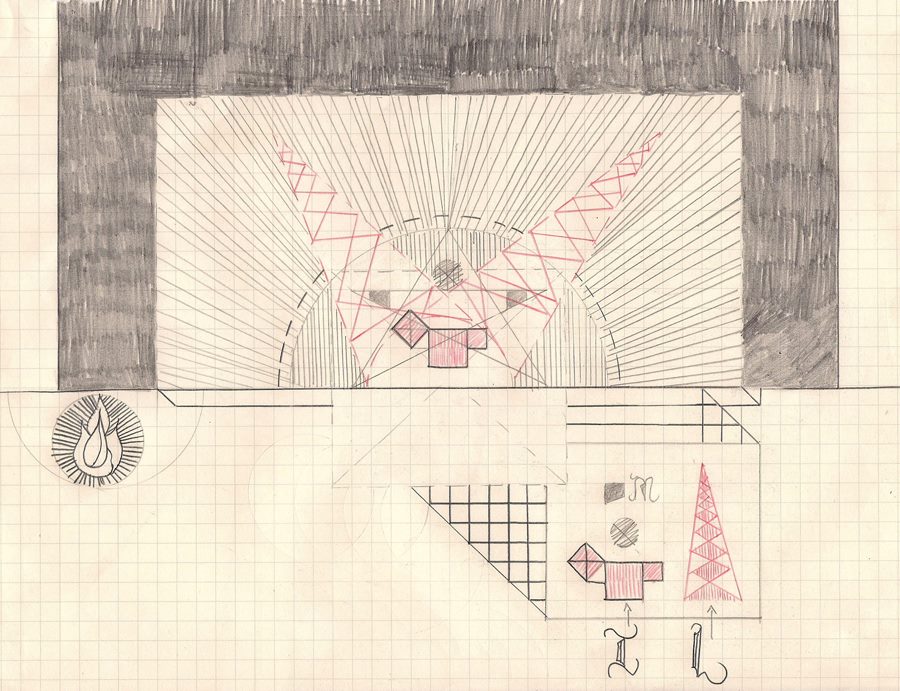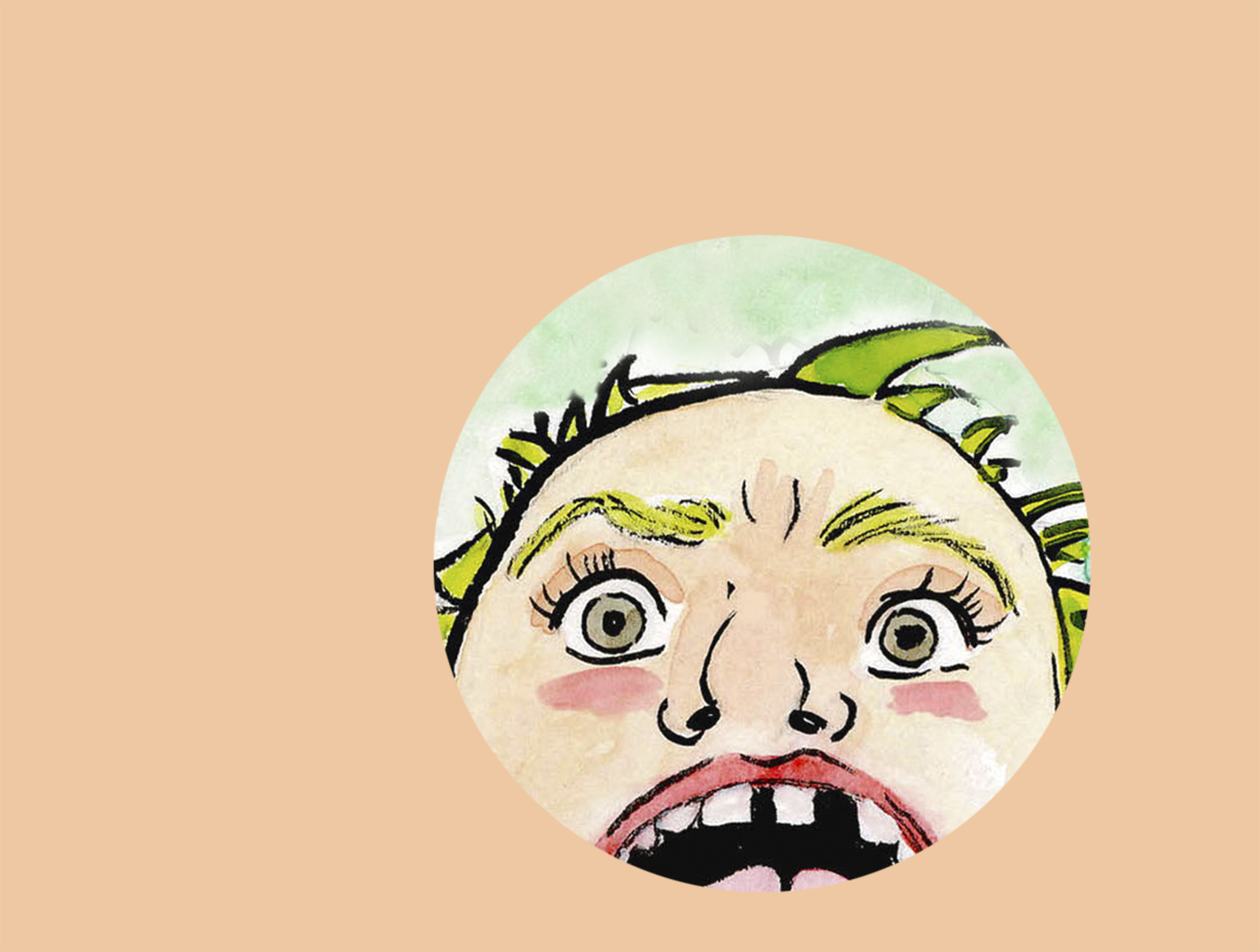“The Celestial Din” opening reception will be held at The Hedreen Gallery on Friday, Sept 6, from 7-9 pm, with a special culminating performance at Lee Center Theater at 9 pm.
Garek J Druss has been flirting with the darker spectrum of human emotion for a while now.
A Story of Rats, Druss’ main musical outlet, set the unofficial record for “Most Fog Pumped into a Club” when I saw them at Chop Suey earlier this year. The only thing you could see through the haze were the ornately arranged lit candles on stage. All the while, A Story of Rats’ doomy liturgy surrounded you in a claustrophobic vice.
Much of Druss’ work deals in this sort of dark sorcery—creating extremely dense, heavy music with the intention of dramatically altering the audience’s emotional state. Druss has also worked with Atriarch, one of my favorite metal groups from Portland, a band that similarly conjures up an ominous mental shift in audiences. My first Atriarch show felt like being at church, a sort of shawdowy religious rapture that came from the phsyciality of getting hit by a giant dirge.
Druss has also worked with Saint Genet, a local performance art group who similarly deals in altered states, albeit in a more direct way. Saint Genet shows often involve copious amounts of alcohol, whippits, and bloodsucking leeches. More recently the group stepped it up and reenacted Chris Burden’s “Shoot” when Saint Genet’s ringleader Ryan Mitchell was voluntarily shot in the arm before their performance of “Paradisiacal Rites.”
Druss helped compose the music for Paradisical Rites, a macabre kind of shame-ballet full of spiralling bird carcasses and painful feats of physical and pyschic endurance. Druss’ score brilliantly matched the tone of the piece with it’s intensely foreboding timbre. The whole thing made you feel like you had just witnessed some sort of unsanctified omen of dire consequence.
It was dark, to say the least.
Tomorrow at Seattle University’s Hedreen Gallery, Druss will be presenting a new multimedia work called “The Celestial Din.” And for the first time, Druss is sonically experimenting to achieve a very different end.
He wants audiences to feel “uplifted.”
Seattle Weekly chatted with Druss after a rehearsal of the piece about Platonic solids, the musical significance of the ouroboros/infinity symbol in his “visual scores,” and why the sudden cheery mood shift for “The Celestial Din.”
Seattle Weekly: How long have you been working on this piece?
Garek Druss: Well, the research began on it a few years ago, and then within the last year it’s really sped up. Some of the alternative tunings I’m using, they’ve got to do with a collaboration I did with the artist Anna Telcs. That was really the first time I’d taken those tunings outside into the public and I got a really great reaction. This last year actually, after that, I went across Europe and played with those tunings. I guess I’d say it’s been about three or four years of research to kinda get the shift in things.
SW: So when you say you’ve been working on “tunings,” are you talking about guitar tunings?
GD: Yeah, but it’s more than that. So, the standard Western concert pitch is 440HZ, which is where the “A” note is. It’s basically what you measure from to put everything in tune with Western instruments. It’s been the standard since the mid to early 1800s or late 1700s I believe. But before that it was 432HZ, which is what I’ve been playing. So it’s lower in pitch, which I enjoy more just with my ear. It’s easier to harmonize with and a lot more mellow. So you know, the Tibetan singing bowls, the Gregorian chants are all in 432 HZ because that’s just naturally what more humans were responding to. The next A Story of Rats album will be in 432HZ, and our last several performances have also been in 432. So that’s kind of where I set my barometer with my instruments. With my synthesizer, I tune everything down to that.
SW: How does that work? How are you tuning a sythesizer?
GD: It’s the same thing as guitar tuning. I use analog syths, and with those you can tune them by hand. I plug in a standard tuner, not all of them will go down to 432, it’s just a standard thing, but a lot of them you can just set your concert pitch as 432 and go from there.
SW: So what intially sparked your interest in this particular pitch? What set off all this research?
GD: A lot of my music is based in defining architecture and interior space through sound. It’s very ambient and atmospheric. A lot of it’s about seeing how you can effect the emotional quality of the space and your audience just with the frequency and range you are working in. You can use that to have a degree of emotional control and manipulation. I’ve got a whole background of performing and recording for about 10 years now and its all sort of lead up to looking at it from a different side. You know, maybe from a more… uplifiting or beneficial standpoint? Rather than using it to change or manipulate or control, just more sort of coming at it from a positive light.
SW: Well, so I’ve seen A Story of Rats before…
GD: Oh, you have?
SW: Yeah, and I’ve seen Atriarch and a lot of the stuff you’ve done with Saint Genet. And, it’s true, I mean with A Story of Rats you guys pump all this fog into the audience…
GD:
*Laughs* Yeah we have a tendency to do that.
SW: Which I love, and it is this kind of drone that alters how you feel, but I wouldn’t necessarily describe that work or what you’ve done with Atriarch or Saint Genet as uplifting in any way. This “uplifiting” vibe seems like sort of a newfound thing for you.
GD: No, no, I agree with you, Atriarch is definitely in a whole other boat. It’s very heavy and dark work, as much as those gentlemen are uplifiting people. And A Story of Rats, you know, everyone involved is certainly out for the greater good of humanity. It’s just very very heavy and very demanding music.
So then you would understand my shift because a lot of my work and my background is very heavy and very demanding. A lot of A Story of Rats is about creating that claustrophobic atmosphere, you know, with that much fog and the repititious tonality. This is where I break away now. That work is still pleasant and still going on, but I’m definitely stepping away and more experimenting with this stuff, which would be more of… well… uplifting. In the sound installation I’ve made out of paper speakers that go with the composition I’ll be performing, a lot of the tones that will come out of them have been known to reportedly affect people and bring about transformation.
One of the frequencies, 528, which is coming out of the tetrahedron sculpture, is said to repair DNA.
SW: Whoa.
GD: There’s scientific evidence that that tone will heal DNA. So I’m taking all these things and tossing it back through my background in sound, which involves a lot of polyphonic tones.
SW: With the name “Celestial Din” are you sort of alluding to these cosmic vibrations that you are trying to tap into?
GD: So, there are five speaker sculptures in the sound installation, and each of them is a platonic solid. You know tetrahedron, octahedron, dodecahedron, la di da di da and so on. Those shapes are nature’s basis and first pattern. Those shapes can be found in everything. So when you ask what the “Celestial” thing is, that’s the universe. And then the “Din” is this racket, this sound I’ll be making. That’s how I arrived at that.
SW: I’ve seen you’ll be using these sort of esoteric looking drawings you’ve made as the musical notation for this piece. Can you explain to me how that works?
GD: One of the pieces in there is a score, which is a 22 x 30 watercolor, graphite, and ink drawing. That score isn’t like the normal notation where you start with the clef and write it all out. It’s a visual based document of the score. A lot of the timbre and effect is in there, you know, a lot of this part is going to be very dense and you’ll see all of these lines in the drawing that dicatate how the pieces work. I’ve been working with that for quite a while. I did an exhibit at a gallery about a year and a half ago and in that exhibit were two of the live score drawings I did for the latest A Story of Rats record. That’s essentially how I document and interact with sound before it’s happened.
It’s not like playing something or creating an environment and going “oh yeah, I’ll try and draw that here.” It’s more like actually drawing it out first and interacting with that, and how I see the “piece” acts as my draft for the music. If you look at it and listen to the music, you can definitely see where I’m going, but it’s not something where you can go, “Oh yeah! He’s right here in the piece in the drawing.” It’s a very encrypted and internal dialogue that people aren’t going to get unless they sit down and talk with me. You know, like, “Oh, this infinity sign with the ouroboros represents this part being looped.” It’s very encrypted.
SW: Are there regular codified images or lines and patterns you have that you use to teach people your music with these documents?
GD: I haven’t gone down that route yet. But.. well are you aware of a band named Wolvserpent?
SW: Yeah, the metal group from Boise?
GD: Yeah, so those guys are like family. They’ve been friends with A Story of Rats forever. They are next level musicians, technically proficient and way out of my league. When we were working on our set to go on tour all these years ago, I was having trouble learning their music. I wasn’t visualizing the pieces. We essentially sat down and drew out the songs. I still have this torn up old drawing, I put it in a frame. It was essentially a beginning for me on some level. After drawing it out, that’s how I understood music from that point on.








